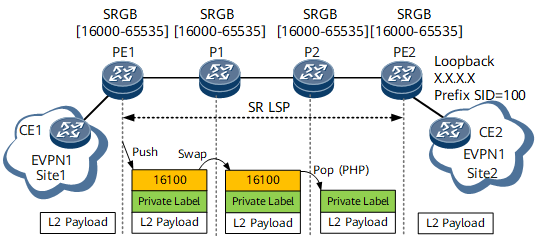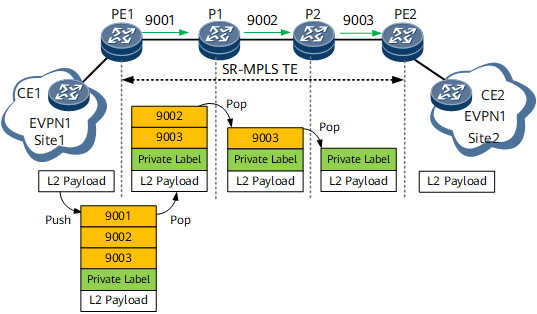EVPN Route Recursion to an SR Tunnel
Ethernet Virtual Private Network (EVPN) is a VPN technology used for Layer 2 or Layer 3 interworking. Similar to BGP/MPLS IP VPN, EVPN extends BGP and uses extended reachability information to implement control-plane instead of data-plane MAC address learning and advertisement between different sites' Layer 2 networks. Compared with VPLS, EVPN tackles the load imbalance and high network resource consumption problems occurring on VPLS networks.

EVPN can be used for both L2VPN and L3VPN. This section uses EVPN L2VPN as an example.
EVPN Route Recursion to an SR LSP
- CE1 sends a unicast packet to PE1 in Layer 2 forwarding mode.
- After receiving the packet, PE1 encapsulates a VPN label carried in a MAC entry and a public SR LSP label in sequence and then sends the encapsulated packet to PE2.

For an EVPN L2VPN, a VPN label usually refers to the label of an EVPN instance. If an EVPN instance consists of multiple broadcast domains, the VPN label can be the label of a specific EVPN broadcast domain. After receiving a packet carrying such a label, the remote PE identifies the broadcast domain based on the label and searches the MAC address table in the broadcast domain for packet forwarding.
- After receiving the unicast packet, PE2 decapsulates the packet, removes the VPN label, and searches the VPN MAC address table for a matching outbound interface.
EVPN Route Recursion to an SR-MPLS TE Tunnel
- CE1 sends a unicast packet to PE1 in Layer 2 forwarding mode.
- After receiving the packet, PE1 encapsulates a VPN label carried in a MAC entry and a public SR-MPLS TE tunnel label in sequence and then sends the encapsulated packet to PE2.
- After receiving the unicast packet, PE2 decapsulates the packet, removes the VPN label, and searches the VPN MAC address table for a matching outbound interface.

